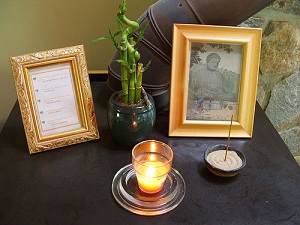 Altars and Shrines: What Are They?
Altars and Shrines: What Are They?
Archeologists have found evidence of altars and shrines in nearly all places where there is evidence that humans have lived. The predisposition to construct these kinds of sacred creations seems almost to be part of our DNA. Traditionally, shrines are memorials or monuments to the dead. We have made shrines for thousands of years throughout the world’s cultures.
Some well-known shrines include the Taj Mahal and the Egyptian pyramids. Public monuments such as the Vietnam Veterans’ Memorial, the Mount Rushmore carvings, the Lincoln Memorial, and the Martin Luther King, Jr., Memorial are all examples of secular shrines that honor the memories of individuals whose lives and deaths have influenced our history as well as countless individual lives.
We create shrines in public spaces, in our communities, in places of worship, and in our own private spaces. We create them after long preparation and fundraising, with thoughtful planning, through elaborate installations, as well as with less expense and fanfare. We may place them in our own private spaces, in a community gathering place, or at specific sites where a death or tragedy occurred.
Shrines may evolve as spontaneous collaborations, such as those created by students, faculty and families at Virginia Tech or Columbine after those tragic shootings. Those types of shrines are usually added to throughout the days following the shootings and provide a community gathering space. They become places where the shocked and grieving may seek comfort and support from others. Shared, spontaneous shrines often evolve into more permanent community memorials where the lives of those who died can be remembered. Street memorials, where family and friends lay flowers, trinkets, card, balloons, or works of art where loved ones died, can be found in cities all over our country.
In New York City, throughout the five boroughs, one can see the hundreds of Street Memorial plaques placed at spots where pedestrians were killed on the city streets. That movement arose from the St. Louis, Missouri’s Ghost Bike Memorial project where bicycles are painted white and locked to street signs near crash sites to memorialize bikers who died there. Think also of the highway memorials and shrines that can be seen along our nation’s roadways at the sites where someone’s family member or partner was killed in a crash.
Shrines may be created outside the homes or at the burial sites of well loved public figures or artists who have died, such as those created in honor of John Lennon, Princess Diana, Jim Morrison, and Edgar Allen Poe. Shrines can serve as places for solitude, reflection, and remembering but they can also be whimsical and celebratory like the brightly colored Day of the Dead shrines in Mexico’s annual festivities which celebrate and honor the lives and memories of loved ones who have died with parades, games, picnics and family gatherings. Shrines connect us to our past, to each other, and to something greater than ourselves. They serve to help us remember and to heal.
Sometimes there may be confusion about the differences between shrines and altars. Often, the words altar and shrine are used interchangeably. For the purposes of personal healing from grief, or your own personal spiritual expression, you can use which ever term you like. If religious connotations make you uncomfortable, you may prefer thinking of a personally created altar or shrine as a memorial, memory box, memory space, honoring space, remembering space, meditation space, etc. Your space can be called whatever you choose to call it.
Shrines are typically dedicated to a specific person, or in religious traditions, to a specific deity or saint. In the case of shrines dedicated to people who have died, those can also be considered as memorials. An altar is usually thought of as a sacred space used for specific functions that may be associated with religious and spiritual purposes, such as worship, prayer, rituals or offerings. In religious traditions, the altar is usually the centerpiece of the worship space, such as in a church, synagogue, temple, mosque or sacred circle.
Many people create home altars as a personal sacred space for prayer, reflection, meditation or other specific spiritual and religious pursuits. Home altars can help us focus our minds on our chosen spiritual path and serve as daily reminders of a spiritual focus or our connection to Spirit. Altars may also be created and dedicated to specific deities or saints.
Altars can also be created with people as a focus. In my own home, I have little altars everywhere, with photos of my son, elements of nature (such as stones, shells or flowers), candles, or incense, place with other objects that help me to focus on peace and comfort, such as a lovely little Jizo statue or a statue of Ganesha. Shrines and altars can be as small or elaborate as you like. You may have many different shrines or altars for different things.
Why Create Shrines and Altars?
As the instructors at Life Path Center for Learning and Healing beautifully put it, “altars and shrines are external representations of interior mysteries.” Shrines and altars are ways of showing in tangible form what might be happening in our hearts and spirits. Creating shrines and altars gives us opportunities to remember, to reflect and to honor, as well as to help heal the pain of loss through the act of creating. The creation of a personal shrine can establish a private place to which you can return to reflect, meditate, grieve, engage in a personal ritual, remember, and honor the one who has died.
Small, portable shrines can be carried with you where ever you go. These might be as small as a matchbook that can fit in your pocket or something a bit larger, like the size of a book, perhaps, that might be slipped into a purse or briefcase. A take-along shrine can allow you to maintain a needed connection with your loved one, or to create a sacred space for remembering or engaging in any type of personal ritual any time or place you may need or want to do so. Or you might prefer to create a more permanent shrine or altar that can be set up in your home or on your property using heavier more substantial elements, or a smaller semi-permanent type whose elements can be taken apart and used in other places or spaces. The choices are yours.
Creating Your Shrine
There are no rules or guidelines for creating shrines. The beauty of creating a shrine is that the ideas and materials are seemingly endless and the process, like the grieving process itself, is completely individual. A few guidelines might be helpful as you engage in the creation your own personal shrine.
Before you plan the look of your shrine, spend some time thinking about your loved one without thoughts or preconceived ideas of what you think your shrine might look like. Here are some ideas that may help the process:
- Make a list of words that come to mind when you think of your loved one.
- Make a list of objects or things that you associate with your loved one.
- Write down any words of wisdom, favorite expressions, funny or loving things your loved might have said. If your loved one never spoke, write down memories that have stuck with you, specific times that you continue to return to, that seem to bring some peace and comfort and to remind you of their love.
- Write down nicknames or pet names you might have used for each other and any associations those words may bring up .
- Write down his or her favorite colors, flowers, foods, hobbies, talents, etc.
- Research and find images that correspond to some of the things you have listed. You may find lots of interesting images on the internet that you can print and cut out for use in your creation or seeing the images may spark other thoughts or ideas that you may wish to incorporate in your memorial shrine.
To Create a Take-Along Shrine
Some artists suggest that a container be decided upon first before proceeding. The container may help guide the process or selection of items used in creating your shrine. Some suggestions for containers which can be re-purposed as your moveable shrine:
- Altoid tins (or other candy or gum tins)
- Sliding matchboxes (these can be the very small sized matchboxes or the large kitchen match boxes)
- Jewelry boxes
- Gift boxes
- Cigar boxes
- Shoe boxes
- Deep frames or shadow boxes
- Drawers
- Books (you can make a book into a box by cutting a rectangular shape into the pages and then gluing the pages together to create a container inside the book)
Gather basic craft supplies:
- Scissors
- Glues
- Paints (acrylic craft paint is inexpensive and works well for this purpose)
- Decorative and colored papers
- Photographs, personal objects or other items related to your loved one
- Anything else that you wish to add to your creation, such as
Ribbons, wires, sticks, dried flowers, string, yarn, decorative paper, wrapping paper, rhinestones, shells, small mirrors, glitter, charms, and beads, as well as anything that you like, that speaks to you, and that can be glued down.
Then, begin your process:
- Prepare your surface by painting or covering the outside and then the inside of your container, allow it to dry completely.
- Add background papers or images on the prepared surface if you wish.
- Place the photo(s) of your loved one where you think it should go. Add your embellishments as desired inside and out: beads, glass pebbles, words, charms, etc., until you feel you have completed your shrine.
To Create a Semi-Permanent or Permanent Shrine
To create a semi-permanent shrine, decide on your location or designate a particular space, such as a table top or a special shelf. You may want to visit thrift and antique shops to find the perfect small table or shelf that will serve as the base for your home altar/shrine. Of course, you can re-finish, paint, and decorate these items as you wish, or you may choose to forgo the paints, glues and embellishments.
Your shrine is yours to create as you see fit. Once you’ve found your base, begin the assembling of your sacred space. Gather together meaningful items that will help you focus on your intentions of memorializing, remembering, honoring, and healing. You might want to cover your altar with a special cloth or decorative mat. Next, you may want to place a picture of your loved one in a special frame as the centerpiece of your shrine. Add to this basic memorial anything you wish.
Some Suggestions:
- Personal objects that remind you of, or which are connected to, your loved one. These might include other photos, jewelry, letters or cards he or she gave you, awards, trophies, caps, hats, and other items of clothing, favorite books, or items he or she used on a regular basis such as sewing scissors, razor, comb or brush. The list here could be nearly endless.
- Natural objects such as flowers, fruits, rocks, crystals, shells, sticks or branches from your back yard, pinecones, leaves, abandoned birds’ nests, etc. You may wish to change the natural objects weekly (such as fresh flowers or fruits) or monthly, changing out stones and shells or other things you may find in nature.
- Candles, oil lamps, or incense
- Small strings of lights
- Chimes or bells
- Religious or spiritual objects that speak to you, such as statues or photos of deities or saints, or other religious or spiritual symbols
You may add to or change the objects on your shrine as often as you wish. Many people like to add seasonal items, such as a small Christmas tree or a Menorah during the holidays, various ornaments and items representing special times of the year such as your loved one’s birthday or other special days.
You can use your shrine or altar space simply as a reminder of your loved one or as an active part of creating and conducting your personal grief rituals. The planning, making, building and “adding to,” of your shrine can itself be a healing ritual. What you do with and how you use your creation is entirely your choice. Your creation is as individual as your personal journey through grief toward healing.
Please feel free to share your experiences with your own shrines and altars. If you do not have your own shrine or altar, whether or not you are grieving, consider creating one. Shrines and altars can bring a great deal of peace and comfort, as well as serve as a reminder for us to slow down and focus on those things that are important in our lives—our loved ones, our hearts, and our souls.

The preceding article was solely written by the author named above. Any views and opinions expressed are not necessarily shared by GoodTherapy.org. Questions or concerns about the preceding article can be directed to the author or posted as a comment below.

 Creating Rituals to Move Through Grief
Creating Rituals to Move Through Grief Grief for All Seasons
Grief for All Seasons Communicating 9/11 through the Language of Art
Communicating 9/11 through the Language of Art


Please fill out all required fields to submit your message.
Invalid Email Address.
Please confirm that you are human.
Leave a Comment
By commenting you acknowledge acceptance of GoodTherapy.org's Terms and Conditions of Use.